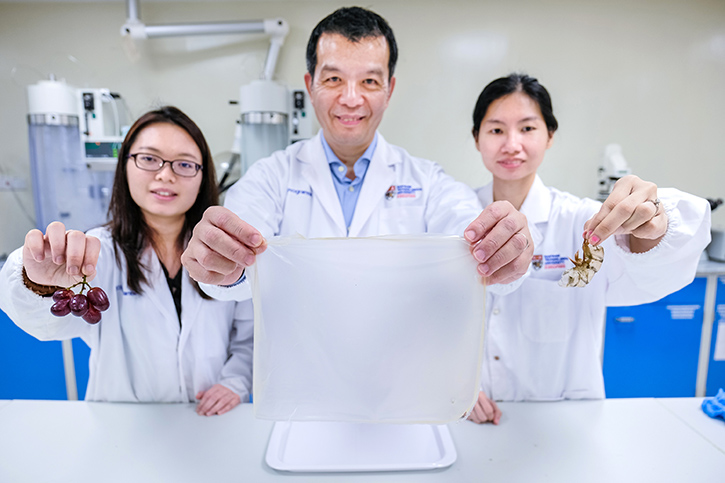May 11 2020
At Nanyang Technological University (NTU) Singapore, researchers have designed a green method to produce chitin, which involves fermenting two forms of food waste—discarded fruit and prawn shells.
 NTU researchers and students developed a new way to sustainably extract chitin from prawn shells using sugars from fruit waste, which can potentially lead to biodegradable food packaging with antimicrobial properties. Image Credit: Nanyang Technological University, Singapore.
NTU researchers and students developed a new way to sustainably extract chitin from prawn shells using sugars from fruit waste, which can potentially lead to biodegradable food packaging with antimicrobial properties. Image Credit: Nanyang Technological University, Singapore.
Chitin finds an extensive range of uses in the food industry, as food stabilizers and thickeners, as well as anti-microbial food packaging.
When compared to existing methods, the NTU technique is more sustainable. The existing methods involve withdrawing chitin chemically from marine waste, which is expensive, requires huge amounts of energy, and results in chemical by-products that might be released in industrial wastewater.
Throughout the world, six to eight million tons of crustacean waste is produced every year, with 45 to 60% of shrimp shells disposed of as processing by-products.
The huge amount of shrimp waste has sparked industrial interest as it is an abundant source of chitin. However, there is a problem in the extraction method, which is both unsustainable and harmful to the environment.
William Chen, Study Lead Author, Professor and Director, Food Science and Technology Program, Nanyang Technological University
Chen added, “Our new method takes crustacean waste and discarded fruit waste and uses natural fermentation processes to extract chitin. This is not only cost-effective, but also environmentally-friendly and sustainable, and helps to reduce overall waste.”
The results of the study were published in AMB Express, a peer-reviewed journal, in January 2020.
The NTU researchers investigated 10 sources of common fruit waste like apple and mango peels, pineapple cores, and red and white grape pomace in several fermentation experiments. The team identified that the fruit waste included sufficient sugar content to drive the fermentation process to disintegrate the prawn shells into chitin.
The team made use of the “X-ray diffraction” method to identify the molecular and atomic structure of chitin made using the new technique, and its purity level was quantified with the help of a “crystallinity index.”
The crude chitin samples that were extracted from prawn shells were fermented using fruit waste that offered a crystallinity index of 98.16%, compared to commercial chitin samples that have an index of 87.56%. Chitin produced by fermentation with the sugar content from the fruit waste was of higher quality than the one produced through the commercial process.
Our research has led to not only higher quality chitin but a more sustainable and environmentally-friendly process too. While the various types of fruit waste produced good results, the sugar from the pomace of red grapes had the best performance.
William Chen, Study Lead Author, Professor and Director, Food Science and Technology Program, Nanyang Technological University
Chen continued, “This is also a cost-effective method for industry-scale operations, which could be of potential interest to wineries looking to reduce and upcycle their waste. This research also echoes NTU’s translational research focus, which aims to develop sustainable innovations that benefit society and industry and create a greener future.”
According to Mr Loo Yuen Meng, Managing Director of Integrated Aqua Singapore Pte Ltd, who did not contribute to the study, “The latest innovations developed by Prof William Chen from the Food Science and Technology program at NTU, is an excellent example of how the expertise from an institute of higher learning can be applied to improve operational efficiency of the food industry while reducing food processing waste.”
Through a simple fermentation process, the high-value chitin and chitosan recovered from the prawn shells are environment-friendly, and the products can be re-connected back to the food industry.
Mr Loo Yuen Meng, Managing Director, Integrated Aqua Singapore Pte Ltd
The NTU research group identified that chitin could be fermented further into chitosan by leaving chitin to undergo additional stages of fermentation. Chitosan can be utilized as a controlled drug delivery system in pharmaceutical treatments or as a growth enhancer in plant fertilizers.
Currently, the NTU researchers are looking for ways to make use of chitosan to improve earlier research innovations like food packaging made using Okara or soybean residue. This method could possibly result in the synthesis of a stronger cellulose film with anti-bacterial and anti-microbial properties.
Professor Chen is also working with several companies to increase the use of greener industrial techniques to produce chitin and chitosan.
Journal Reference:
Tan, Y. N., et al. (2020) Microbial extraction of chitin from seafood waste using sugars derived from fruit waste-stream. AMB Express. doi.org/10.1186/s13568-020-0954-7.
#NTUsg researchers develop sustainable way to create chitin using prawn shells and fruit waste
Video Credit: Nanyang Technological University, Singapore.